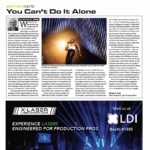When you think of insurance, you think of the door-to-door insurance man like Ned “Needle Nose” Ryerson from the movie Groundhog Day with Bill Murray. Not the most likely of people to be greeted with (at first, at least) a warm embrace. Despite the stereotype, your insurance agent can and should be your best friend.
Insurance is the last thing individuals think about. It should be the other way around — insurance should be a priority. Think about it this way. As an individual working a gig, you are responsible for the gear and running of the show. What happens if something breaks, falls or gets damaged under your watch?
Freelancers Need Protection
Sure, the rental or production company may have coverage, which could help if you are an employee. But their coverage can vary. And if you are classified as a subcontractor or work under a 1099 — regardless of whether you have set yourself up as a sole proprietor or as an LLC — you are more likely to be on your own.
Lets face it, our gear is not cheap. A mid-sized lighting desk costs as much as a car. After investing $20K into a car, would you drive it without insurance? What’s the difference when buying a $20K lighting desk? Do you have the finances available to repair or replace a broken lighting desk? Most don’t, and that is a scary proposition.
There are different types of coverage for those working within our industry:
General Liability
Liability insurance protects people against third party lawsuits and claims that their negligence harmed someone else, or someone else’s property. It protects the insured in the event they are sued for negligence by someone they may not know.
Plainly speaking, General Liability protects you and your business from incurring the costs associated with defending yourself against frivolous and possibly, not so frivolous claims. Anyone can be sued at any time for any thing. General Liability is a must in the business world.
Typically, there are limits to how much coverage you can buy, but the usual rule is $1,000,000 per occurrence and $2,000,000 in the aggregate. It’s possible to buy higher limits, either as primary coverage or with an umbrella policy, but those numbers are something you would have to work out with your insurance agent.
Inland Marine Coverage
No, we are not talking about getting coverage for your next cruise. Inland Marine insurance was originally designed for movable property. This type of coverage works for individuals that are entrusted with the care, custody and control of equipment that has to be transported — whether they own it or not.
If you rent your own equipment and/or run equipment supplied by others, this coverage protects you against something breaking in transit or theft or possibly, fire for a gig. If that lighting desk or other equipment breaks on your watch, this coverage may protect you.
Professional Liability
This is coverage more commonly known as Errors and Omissions coverage or E&O. It provides protection when your advice, design or consultation was sought and something did not go as planned.
It is typically purchased when professionals hold themselves out to be experts within particular skill areas. The coverage protects your design work. If a company finds fault in your design and seeks damages, Professional Liability helps protect your design against lawsuits.
Digital Assets Coverage
A recently new coverage, Digital Assets Coverage is aimed at content creators like photographers, videographers and film makers, people looking to cover not just physical property, but digital property like digital photos, videos and so forth. The coverage may provide either for monetary reimbursement or replacement (e.g., repurchase) of the digital assets and/or for backup services to backup insured digital assets so that the insured digital assets may be retrieved if the original user copies are lost.
What’s Right for You?
Coverage of any sort is a good start. General Liability is a great first stepping-stone to protecting your name, business and reputation. From there, adding additional coverage for your specific type of work is something to discuss with a professional.
Yes, insurance cost money and eats away at your net profits for the year. If you can see into the future and know that you’ll never be liable, then forget everything I just said. For those of us without the power of soothsaying, talk with an insurance agent — they don’t bite, they are out to help protect you.
For Justin Lang’s online introduction to PLSN’s June 2013 issue, go to www.plsn.me/201306ednote


